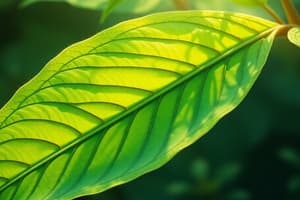Podcast
Questions and Answers
Which part of a leaf is primarily responsible for photosynthesis and material storage?
Which part of a leaf is primarily responsible for photosynthesis and material storage?
- Petiole
- Palisade Mesophyll
- Stipules
- Leaf Blade (correct)
What type of leaf arrangement has three or more leaves per node?
What type of leaf arrangement has three or more leaves per node?
- Fascicled
- Whorled (correct)
- Alternate
- Opposite
How do C4 plants adapt to avoid photorespiration?
How do C4 plants adapt to avoid photorespiration?
- By separating fixation in bundle sheath and mesophyll cells (correct)
- By reducing leaf surface area
- By fixing CO₂ into a 3-carbon compound
- By increasing chloroplast density in leaves
Which type of leaf composition consists of a single undivided blade?
Which type of leaf composition consists of a single undivided blade?
What is the primary function of the palisade mesophyll in leaf anatomy?
What is the primary function of the palisade mesophyll in leaf anatomy?
The ______ attaches the leaf to the stem.
The ______ attaches the leaf to the stem.
The ______ mesophyll is tightly packed and primarily involved in light absorption.
The ______ mesophyll is tightly packed and primarily involved in light absorption.
In monocots, leaf venation is typically ______, where veins run parallel to each other.
In monocots, leaf venation is typically ______, where veins run parallel to each other.
The process of ______ involves the fixation of carbon dioxide into sugar during photosynthesis.
The process of ______ involves the fixation of carbon dioxide into sugar during photosynthesis.
Shade leaves are typically ______, larger, and have fewer chloroplasts compared to sun leaves.
Shade leaves are typically ______, larger, and have fewer chloroplasts compared to sun leaves.
Flashcards
Leaf Blade
Leaf Blade
The flat, expanded part of a leaf responsible for photosynthesis and storing materials.
Simple Leaf
Simple Leaf
A leaf with a single, undivided blade.
Parallel Venation
Parallel Venation
Veins run parallel to each other, characteristic of monocotyledonous plants.
Palisade Mesophyll
Palisade Mesophyll
Signup and view all the flashcards
What is the function of rubisco?
What is the function of rubisco?
Signup and view all the flashcards
Opposite Leaf Arrangement
Opposite Leaf Arrangement
Signup and view all the flashcards
Compound Leaf
Compound Leaf
Signup and view all the flashcards
What is the function of stipules?
What is the function of stipules?
Signup and view all the flashcards
What is the difference between sun leaves and shade leaves?
What is the difference between sun leaves and shade leaves?
Signup and view all the flashcards
What is the function of the mesophyll?
What is the function of the mesophyll?
Signup and view all the flashcards
Study Notes
Leaf Structure and Function
- Petiole: Attaches the leaf to the stem.
- Midrib: Provides structural support, the central vein.
- Lateral Bud: Growth point for shoots, branches, and flowers.
- Stipules: Protect developing leaves or buds.
- Leaf Blade: Site of photosynthesis and material storage.
- Leaf: Photosynthesis (food production and oxygen release).
Leaf Arrangements and Types
- Leaf Arrangement:
- Alternate: One leaf per node.
- Opposite: Two leaves per node.
- Whorled: Three or more leaves per node.
- Fascicled: Leaves in tight bundles.
- Leaf Composition:
- Simple: Single, undivided blade.
- Compound: Divided into multiple leaflets.
- Palmately Compound: Leaflets radiate from a single point.
- Pinnately Compound: Leaflets arrange symmetrically along a central axis.
Leaf Venation
- Parallel: Veins run parallel (characteristic of monocots).
- Reticulate: Veins form a net-like pattern (characteristic of eudicots).
Leaf Anatomy and Photosynthesis
- Anatomy:
- Mesophyll: Internal leaf tissue.
- Palisade Mesophyll: Tightly packed cells for light absorption.
- Spongy Mesophyll: Loosely arranged cells for gas exchange.
- Veins: Xylem (transports water) and phloem (transports sugars) connect to the plant's vascular bundles.
- Mesophyll: Internal leaf tissue.
- Photosynthesis Overview:
- Inputs: Carbon dioxide (CO₂), water (H₂O), and sunlight.
- Outputs: Sugars and oxygen (O₂).
- Rubisco: Enzyme crucial for carbon dioxide fixation in the Calvin cycle.
- Photorespiration:
- Conditions: Occurs when oxygen levels are high and carbon dioxide levels are low.
- Avoidance in C4 Plants:
- Adaptations: Specialized spatial separation of bundle sheath and mesophyll cells.
- Mechanism: Initial CO₂ fixation into a 4-carbon compound using PEP.
Leaf Modifications
- Environment-Based Modifications:
- Sun Leaves: Thicker, smaller, with more chloroplasts.
- Shade Leaves: Thinner, larger, with fewer chloroplasts.
- Xerophytes (Dry Environments): Thick, leathery leaves, often with adaptations for water storage.
- Hydrophytes (Aquatic Environments): Leaves with air spaces and stomata on the upper surface.
- Other Modifications:
- Bulbs: Storage leaves (e.g., onions).
- Tendrils: Climbing structures (e.g., pea plants).
- Spines: Leaves replaced by sclerenchyma (e.g., cacti).
- Thorns: Modified stems.
- Bracts: Specialized leaves near flowers.
Studying That Suits You
Use AI to generate personalized quizzes and flashcards to suit your learning preferences.




